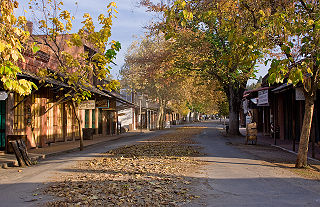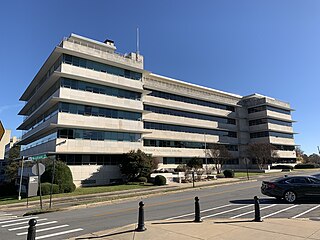
The Arkansas Post was the first European settlement in the lower Mississippi River Valley and present-day Arkansas. Henri de Tonti established it in 1686 as a French trading post on the lower Arkansas River. The French and Spanish traded with the Quapaw people for years.

Columbia State Historic Park, also known as Columbia Historic District, is a state park unit and National Historic Landmark District preserving historic downtown Columbia, California, United States. It includes almost 30 buildings built during the California Gold Rush, most of which remain today. It was declared a National Historic Landmark in 1961.

Arkansas Baptist College (ABC) is a private, historically black liberal arts college in Little Rock, Arkansas. Founded in 1884 as the Minister's Institute, ABC was initially funded by the Colored Baptists of the State of Arkansas. It is the only historically black Baptist school west of the Mississippi River. The Main Building on its campus, built in 1893, is one of the oldest surviving academic buildings in the state, and was listed on the National Register of Historic Places in 1976.

The Rush Historic District is a zinc mining region of the Ozark Mountains in Arkansas. Now located within Buffalo National River, the district includes ruins dating from 1880 to 1940. The area was an important part of what became known as the North Arkansas Lead and Zinc District, and played a role in the development of railroads and modern infrastructure in the area.

U.S. Route 64 is a U.S. highway running from Teec Nos Pos, Arizona east to Nags Head, North Carolina. In the U.S. state of Arkansas, the route runs 246.35 miles (396.46 km) from the Oklahoma border in Fort Smith east to the Tennessee border in Memphis. The route passes through several cities and towns, including Fort Smith, Clarksville, Russellville, Conway, Searcy, and West Memphis. US 64 runs parallel to Interstate 40 until Conway, when I-40 takes a more southerly route.

The Rusher Hotel, also known as the Great Southern Hotel, is a historic hotel building at 127 West Cedar Street in Brinkley, Arkansas. It was built in 1915 to serve the Brinkley Union Station. It is a three-story brick building, whose main entrance originally faced the railroad, but was reoriented to the street facade after the railroad declined in importance.

The University of Arkansas Campus Historic District is a historic district that was listed on the National Register of Historic Places on September 23, 2009. The district covers the historic core of the University of Arkansas campus, including 25 buildings.

The War Eagle Bridge is a historic bridge in War Eagle, Arkansas, United States, that is listed on the National Register of Historic Places.

U.S. Highway 71 is a U.S. highway that runs from Krotz Springs, LA to the Fort Frances–International Falls International Bridge at the Canadian border. In Arkansas, the highway runs from the Louisiana state line near Doddridge to the Missouri state line near Bella Vista. In Texarkana, the highway runs along State Line Avenue with US 59 and partially runs in Texas. Other areas served by the highway include Fort Smith and Northwest Arkansas.

Oakland, also known as the Dr. Garland Doty Murphy House, is a historic house at 3800 Calion Road in El Dorado, Arkansas. It is a 2 1⁄2-story wood-frame structure resting on a brick foundation, with a gabled roof and clapboarded exterior. A flat-roofed porch, two stories in height, extends across the front facade, supported by square box columns. It has a symmetrical five-bay facade, with a center entrance surmounted by a semicircular pediment. The house was built in 1939 to a design by David Weaver, and is a prominent local example of Colonial Revival architecture.

The Benjamin Franklin Johnson II Homestead District encompasses a late 19th to early 20th century farmstead at 3150 West Pear Lane in Fayetteville, Arkansas. The district's principal built features are the 1925 Craftsman style house of Benjamin Franklin Johnson II, and the 1933 Johnson Barn built by his son, which is separately listed on the National Register. Additional features of the district include foundational remains of farm outbuildings, a stone wall and dam, and the remains of the family orchard. The complex is a comparatively well-preserved example of a period farm complex.

The William H. Norwood House is a historic house at 1602 West Main Street in Russellville, Arkansas. It is a two-story frame structure, finished in red brick veneer and covered by a hip roof. The main block of the building is extending to the side and rear by single-story extensions, one of which includes an enclosed rear porch. The house was built in 1917 for William H. Norwood, a local merchant. It is a rare surviving example in the community of a large-scale residence with high quality Craftsman and Prairie School features. The area where it stands was once predominantly residential, but has in recent years become more commercial. The house is now occupied by professional offices.

The Eugene Towbin House is a historic house at 16 Broadview Drive in Little Rock, Arkansas. It was built in 1960 to a design by Hollis Beck, and is a good local example of Mid-Century Modern architecture. It is a single-story frame structure, its walls finished in vertical board siding and resting on a concrete block foundation. It is covered by a low-pitch side-facing gabled roof with deep eaves. The roof extends to the right beyond the main block to also shelter a carport. Eugene Towbin, for whose family the house was built, was a prominent physician in Little Rock.

The National Old Line Insurance Company Building is a historic office building at 501 Woodlane Street in Little Rock, Arkansas. It is a modern six-story structure of concrete and steel, occupying much of the city block bounded by Woodlane, Capitol, Sixth, and Victory Streets. It is directly across Woodlane Street from the Arkansas State Capitol, and presently houses state offices. It was designed by Arkansas architect Yandell Johnson and built in 1953–54, with an addition in 1964–54. The exterior is characterized by alternating horizontal bands of windows and limestone panels, which encircle the structure. It is regarded as one of the best examples in the state of the International style of architecture.

The Morris House is a historic house at 16284 Arkansas Highway 89 in Lonoke, Arkansas. It is a large single-story structure, measuring about 150 feet (46 m) in length and 50 feet (15 m) in width, set on lot about 4 acres (1.6 ha) in size. Its walls are finished in brick and vertical board siding, and it is covered by a gable-on-hip roof which has a clerestory window near the center where the chimney is located. The house was designed by architect Fred Perkins in 1962 for the family of William Henry Morris, a prominent local farmer. It was built in 1963 and is a good local example of Mid-Century Modern architecture.

The Muxen Building is a historic former school building in rural Crawford County, Arkansas. It is located on the west side of United States Route 71 south of Winslow, and next door to the Our Lady of the Ozarks Shrine. It is a single-story stone structure, built out of local fieldstone and set on a concrete foundation. It is covered by a broad hip roof with exposed rafter ends and projecting balconies on two sides. It was built to house a craft school founded by Clara Muxen, a Roman Catholic nun whose inspiration also led to the construction of the adjacent shrine.

The R.A. Pickens II House is a historic house at 1 Pickens Place in Pickens, Desha County, Arkansas. It is a 2-1/2 story brick structure, with a side gable roof that projects over the front facade to form a porch supported by square wooden columns with Doric elements. The main entrance is centrally located, with a keystoned semicircular transom and matching sidelight windows. The house was built about 1940 using elements of the former Pickens plantation house, which had been built on the site in the 1880s. The Pickens family, which still owned the house in 2019, operated one of the largest plantations in Desha County. The house is one of the area's finest examples of Colonial Revival architecture.

The Dr. Albert H. Tribble House is a historic house at 100 Trivista Right Street in Hot Springs, Arkansas. It is a 3 1⁄2-story brick building, with a gabled roof and Classical Revival styling. Its main facade is symmetrical, with tall ground-floor windows flanking the main entrance, which has an arched transom and sidelight windows. It was built in 1938, and is possibly a design of Hot Springs architect Iven Donald McDaniel. Albert H. Tribble, for whom it was built, was prominent local physician.











